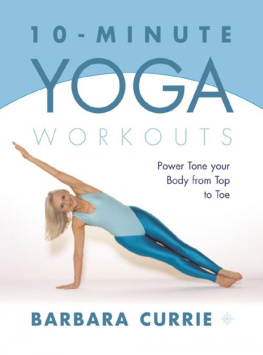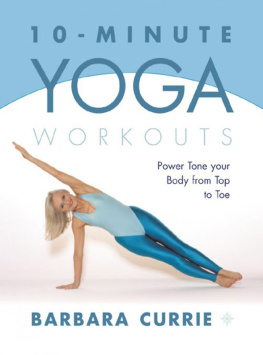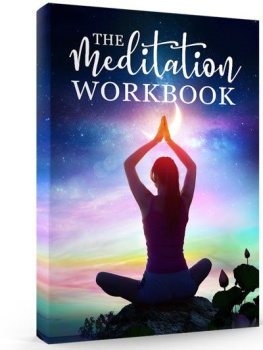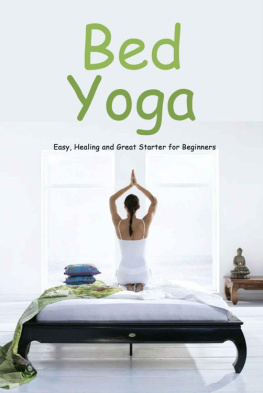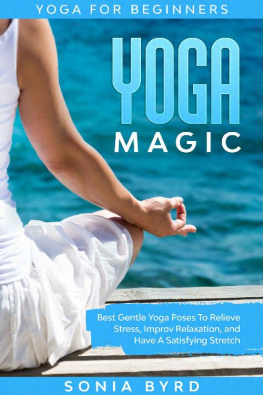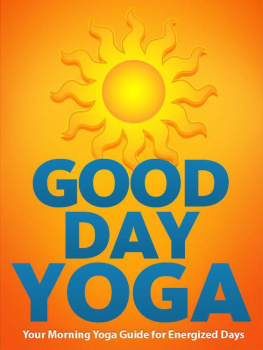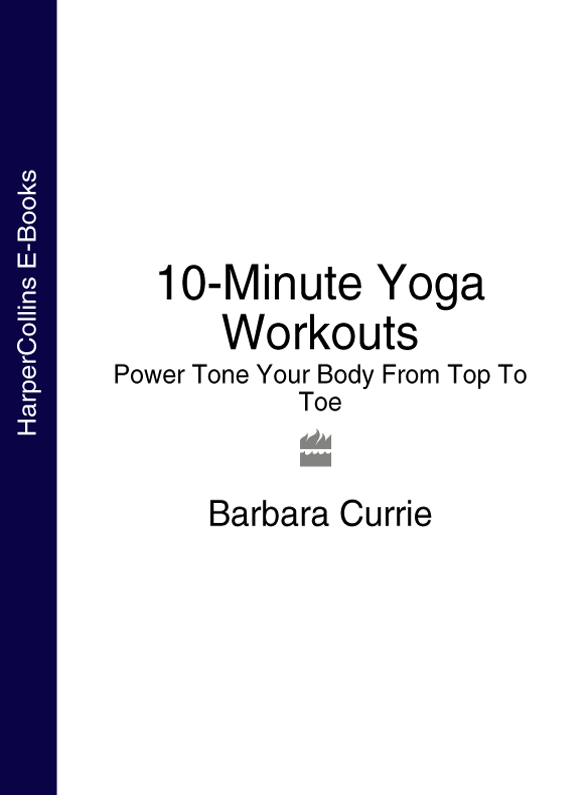I would like to thank: Wanda Whiteley for her enthusiasm and encouragement and for making this book possible; Samantha Grant for all her help and creative ideas with our photoshoot; Simon Gerratt; Matthew Cory for his wonderful work in editing my initial script; Guy Hearn for his brilliant photography and his patience and help with the photoshoot; Sallyann Sexton for my beautiful make-up and hair-dressing in impossible positions; Polly Zabari for typing my script and meeting all my deadlines with a big smile despite giving birth halfway through the book; Julie Drakeford-Lewis, Kelly Defoy, Claire Mullins and Jay Ridout, my yoga A-Team, for posing so beautifully for the illustrations in this book; and Joanne Cassidy for her patience and help during the photoshoot; Natasha Fidler for her beautiful page design and Sonia Dobie for the wonderful cover.
Not all exercises are suitable for everyone. To reduce the risk to you, please consult your doctor before beginning this exercise programme. The instructions and advice presented are in no way intended as a substitute for medical guidance. The writer and publishers of this book do not accept any responsibility for any injury or accident as a result of following this exercise programme.
Ill never forget my first yoga class. It was one grey dreary Monday morning that I ventured inside a hall on the outskirts of Glasgow, and enrolled for yoga lessons. At that time I felt tired, stiff, out of shape and frazzled, due to having just moved house with two children under the age of 3. I had only a vague idea about yoga but thought that it might help me reshape my body after the birth of my children, and also help me to get to know my new neighbours.
It was an incredibly humbling experience, I couldnt believe how stiff and uncoordinated I was, I was only 29 but people twice my age were in much better shape and much more flexible than me. My biggest shock was seeing my teacher, then in her late fifties, move effortlessly into seemingly impossible positions with the agility of a child. Her body was fantastic she was slim and perfectly toned but it wasnt just this that amazed me; it was something much, much more. She had an energy that literally radiated from her, lighting up the room.
I left the class feeling so much better, my tiredness had gone, I felt calmer and more in control. I was walking taller and felt uplifted by the experience. One thing was certain yoga was definitely for me. As I continued with the classes, I was thrilled by the progress I was making, my body had become firmer, my flexibility had improved and my energy level was getting better and better.
Eventually I decided to take a three-year teacher training course and this gave me a fantastic understanding of yoga, its history, philosophy and many uses. Over the years I have continued to study and teach yoga at my yoga school in Surrey and I have taught literally thousands of pupils. I have now perfected my own method of teaching which, I feel relates this brilliant 5,000-year-old system to the needs of people living today.
I am delighted to have this wonderful opportunity of sharing it with you. I do hope you will enjoy it and will benefit tremendously from its age-old secrets.
A Brief Word About Yoga
The word yoga means union of body, mind and spirit with the universal spirit. The yogis of ancient India realized that for perfect health and inner peace, both body and mind must work together in perfect harmony. Yogas combination of intricate physical postures, deep breathing exercises, balances, relaxation and meditation are the perfect discipline to relieve stress, calm the mind and tone the entire body, both inside and out.
In his quest to earn more, do more and have more, modern man subjects himself to increased physical and mental stress. The pace of life is now so fast that few of us have time to enjoy the present moment and just be.
Continued stress on both body and mind increases our vulnerability to disease. Unfortunately, although medicine has made many amazing breakthroughs in the West over the last hundred years, the focus continues to be on treating diseases and not their causes. This is where yoga can help us all so much. Stress or tension literally strangles our bodies, inhibiting blood flow to our tissues. Yogas beautiful physical movements, combined with deep breathing exercises, will carefully rid the body of tension and stimulate oxygen-rich blood to our cells, so providing them with the nutrients that they require. As well as toning all our muscles, the physical exercises will also strengthen our bones and keep our spine and joints flexible. The lymphatic system, which fights infection and carries away toxins, is inhibited during times of stress, but as yoga carefully smoothes away the tension, it can resume its natural functions.
Yogas calming balances necessitate tremendous concentration and so they take the mind off its day-to-day activities, giving it a rest. The most difficult thing to discipline, however, is the human mind. Here again yoga offers us many techniques, from breathing exercises to relaxation and meditation, which may be used to calm a turbulent mind. Gradually and with continued practise the combined discipline of the exercises together with the breathing and meditation will help us to achieve the peace and calm we desire. And just as stress inhibits our energy flow, a calm and peaceful mind will lead to abundant energy and that genuine good to be alive feeling.
Eventually, we stop looking elsewhere for our pleasures and concentrate on looking within, disciplining our mind to search inside ourselves for our joy and happiness. We then start to enjoy the present moment, and listen to our gut instincts, finally achieving self-realization and finding the true health and happiness that is within us all.
THE ORIGINS OF YOGA
It is unclear when yoga actually originated, but seals were discovered depicting a yoga posture during the excavation of some ruins in prehistoric India in an area that now lies in Pakistan. These ruins revealed a very advanced civilization dating to around 5000BC.
The earliest texts mentioning yoga were the Vedas, and these seem to have spanned about 2,000 years, from 30001200BC. These texts were followed by the Upanishads, written between 800 and 400BC. The word Upanishad literally describes a sitting where the master or guru instructs his pupils. This is how yoga has been passed on from generation to generation, over the years. The spirit of the Upanishads can be compared with that of the New Testament The Kingdom of God is within you.
Meditation is a truth higher than thought. The earth seems to rest in silent meditation; and the waters and the mountains and the sky and the heavens seem all to be in meditation. When a man achieves greatness on this earth, he has his reward according to his meditation.
CHANDOYA UPANISHAD 7.6
The Bhagavad Gita, dating from about 500BC, tells of the struggle of the human soul, helping it to find God in all things and all things in God. It tells of a great battle for the rule of a Kingdom or the Kingdom of the soul, a battle between the forces of light and darkness. It shows that this is a battle that affects us all.
The Patanjalis Yoga Sutras, written between 200BC and 200AD, are a crucial yoga text. Patanjali wrote of a practical eight-part approach to yoga, frequently referred to as the Eight Limbs of Yoga.

